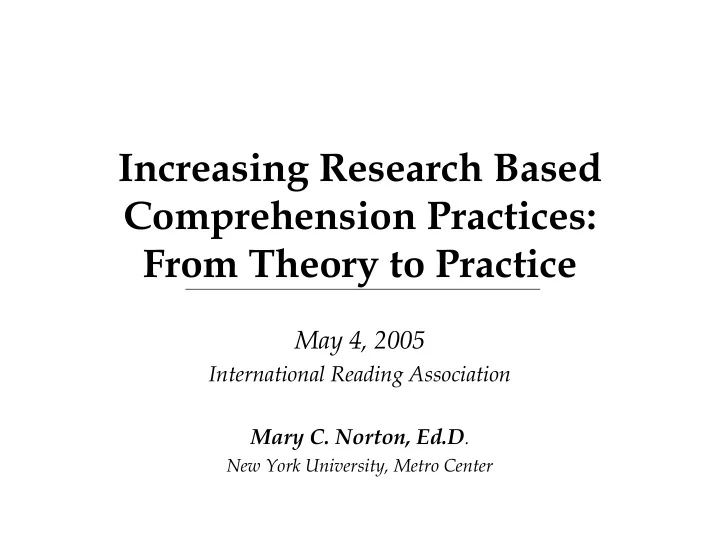

Increasing Research Based Comprehension Practices: From Theory to Practice May 4, 2005 International Reading Association Mary C. Norton, Ed.D . New York University, Metro Center
The Story Once upon a time there was…….. A PROBLEM in the kingdom.
The kingdom • A large city school district with many underperforming schools
The problem • From 50% to 85% of the children in the kingdom were struggling to understand what they read based on State wide standard based assessments.
The Setting: 3 urban schools Similarities • Hi-poverty, low SES • Over 90% of students receive free lunch • 99% minority, 8% ELL • 13% recent immigrants (Haiti, Jamaica, Trinidad and Tobago, Guyana) • Over 30% teachers have less than 2 years experience
The Plot • To improve the reading comprehension of the children of the kingdom and have students read text with understanding • To translate research based reading comprehension knowledge into practice in the schools of the kingdom
The Characters SUPPORTING MAIN CHARACTERS CHARACTERS • CLASSROOM TEACHERS • Project Director • STUDENTS • School Literacy coaches • BUILDING PRINCIPALS • Support/special teachers • PROJECT • District office staff CONSULTANTS/ COACHES
Problem Solving Actions • Needs Assessment • Use of existing student data • Identify focus areas • Provide 2 tiers of support • Select comprehension research based on school data • Some of research used in Literacy Institutes in 2 schools
Partnership and Collaboration Goals • Increase the internal capacity of school staff in reading instruction. • Use common research based knowledge to improve ELA instructional coherence from grade to grade • Develop cadre of literacy leaders in schools to share and increase total ELA expertise
Institutes and Meetings Used the following research to develop: • K-5 common knowledge of essential components of reading across grades. • Vertical understanding of ELA Standards by all staff • Entry expectations and exit outcomes based on standards and ELA assessment • Practical application to Balanced Literacy
PYRAMID OF COMPREHENSION SUCCESS Improved Student Reading Achievement H t n i g e h m Success e p r Achieved o E l x e p v e Balanced e c D t a Comprehension t l i l o i k Instruction n S s – > Sufficient Materials and - H s i g Opportunities e h i g Q e u t Reading Volume; Concept a a l r i t t Oriented Reading Instruction S y T . p a m Comprehension Strategies and Routines l k o Student Questioning C Foundational Skills…Decoding Ability, Fluency Enhanced Vocabulary .. Oral Comprehension
Some of the Causal Links Between Vocabulary Knowledge and Reading Comprehension Metalinguistic Word Recognition Awareness Reading Comprehension Vocabulary Graves William Nagy
Some of the Causal Links Between Vocabulary Knowledge and Reading Comprehension Knowledge About Knowledge of Phonemes and Print Morphemes Metalinguistic Word Recognition Awareness Reading Comprehension Vocabulary Word Recognition (Dickenson Model) Phonological Awareness Receptive Vocabulary Adapted from:William Nagy
Reading volume: Reciprocal effects The result: Strong reading skills Increased reading volume Improved reading volume Increased motivation to read Increased decoding skills More rewarding reading experience Increased fluency Increased reading comprehension Increased vocabulary
Instructional Implications for Improving Students’ Reading Comprehension Teacher knowledge of Adequate reading research based best materials and time practices Student/text match Teacher understanding of comprehension elements IMPROVED READING and how to teach them. COMPREHENSION Use of Multiple Comprehension Strong foundation strategies, building of decoding. fluency, background knowledge and vocabulary skills
The Teacher’s Role in Improving Reading Comprehension Read narrative and informational text to match students’ experiences and interests Provide Model thinking opportunities for process aloud The Teacher’s Role students to transfer these abilities to independent reading Ask High Quality questions. Encourage and Increase student questioning abilities.
The Student’s Role in Improving Reading Comprehension Select appropriate narrative and informational text for interest and information. Respond to text Explain thinking using a variety of process. Ask h igh The Student’s Role strategies. quality questions. Access appropriate strategies to increase text understanding.
Examples of High Quality Talk Strategy for Teacher and Student • Are you talking about this topic • I agree…because… • I disagree…because…. • Please repeat that using your own words. • Can you give an example? • How do you know this? • Why do you think this? • Can you say more about …….? • I don’t understand. Can you say that another way
Trouble Shooting Strategies Comprehension • Reread the sentence if you have stopped to figure out words. • Look back in passage for information • Consider options. What is possible, what is probable? • Come to a conclusion. • See if it makes sense
The Story (to be continued) Findings and Implications: • Levels of progress • What we learned • Next Steps
Resources • Adams, M.J. (2000). Beginning To Read:Thinking and Learning about Print. Cambridge, MA: The MIT Press • Beck I.L. et al. (1996) Questioning the Author:A yearlong classroom implementation to engage students with text. The Elementary School Journal, 96, 385-414. • Dickenson,D.K.& Smith,M.W.(1994)Long-term effects of preschool teachers’ book readings on low-income children’s vocabulary and story comprehension. Reading Research Quarterly,29(2), 104-122.
Resources • Duke,N.K.& Pearson,P.D.(2002). Effective practices for developing reading comprehension, In A.E.Farstrup& S.J.Samuels(Eds.), What research has to say about reading instruction (3rded))pp.205- 242)Neward,DE:International Reading Association • New York State Education Department. Early Literacy Guidance, Prekindergarten- Grade 3. available, http:// www. nysed.gov • Report of the National Reading Panel, (December, 2000). Teaching Children to Read: Chapter 4. • www.early reading.info – website developed by Pacific Resources for Education and Learning (PREL).Provides online support for those responsible for young children’s reading achievement. The reading research and literature found on this website will help teachers, principals, parents with decisions about developing young readers. It includes the 5 components of reading and reading instruction for pre-K to grade 3 learners.
Recommend
More recommend